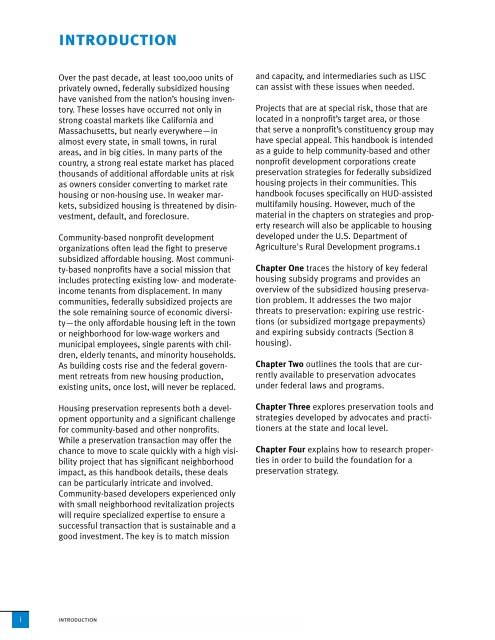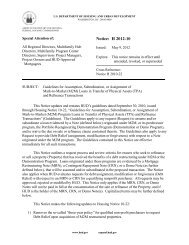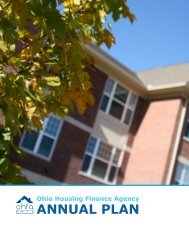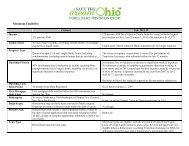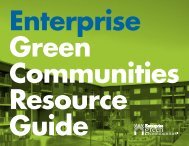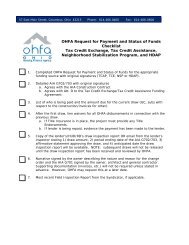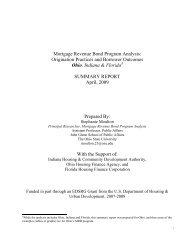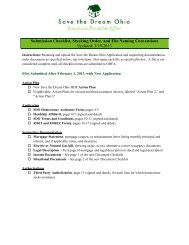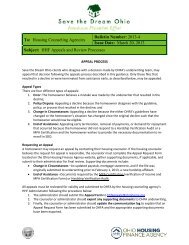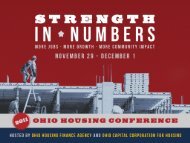lis 217 stemming the tide - LISC
lis 217 stemming the tide - LISC
lis 217 stemming the tide - LISC
- No tags were found...
Create successful ePaper yourself
Turn your PDF publications into a flip-book with our unique Google optimized e-Paper software.
introductionOver <strong>the</strong> past decade, at least 100,000 units ofprivately owned, federally subsidized housinghave vanished from <strong>the</strong> nation’s housing inventory.These losses have occurred not only instrong coastal markets like California andMassachusetts, but nearly everywhere—inalmost every state, in small towns, in ruralareas, and in big cities. In many parts of <strong>the</strong>country, a strong real estate market has placedthousands of additional affordable units at riskas owners consider converting to market ratehousing or non-housing use. In weaker markets,subsidized housing is threatened by disinvestment,default, and foreclosure.Community-based nonprofit developmentorganizations often lead <strong>the</strong> fight to preservesubsidized affordable housing. Most community-basednonprofits have a social mission thatincludes protecting existing low- and moderateincometenants from displacement. In manycommunities, federally subsidized projects are<strong>the</strong> sole remaining source of economic diversity—<strong>the</strong>only affordable housing left in <strong>the</strong> townor neighborhood for low-wage workers andmunicipal employees, single parents with children,elderly tenants, and minority households.As building costs rise and <strong>the</strong> federal governmentretreats from new housing production,existing units, once lost, will never be replaced.Housing preservation represents both a developmentopportunity and a significant challengefor community-based and o<strong>the</strong>r nonprofits.While a preservation transaction may offer <strong>the</strong>chance to move to scale quickly with a high visibilityproject that has significant neighborhoodimpact, as this handbook details, <strong>the</strong>se dealscan be particularly intricate and involved.Community-based developers experienced onlywith small neighborhood revitalization projectswill require specialized expertise to ensure asuccessful transaction that is sustainable and agood investment. The key is to match missionand capacity, and intermediaries such as <strong>LISC</strong>can assist with <strong>the</strong>se issues when needed.Projects that are at special risk, those that arelocated in a nonprofit’s target area, or thosethat serve a nonprofit’s constituency group mayhave special appeal. This handbook is intendedas a guide to help community-based and o<strong>the</strong>rnonprofit development corporations createpreservation strategies for federally subsidizedhousing projects in <strong>the</strong>ir communities. Thishandbook focuses specifically on HUD-assistedmultifamily housing. However, much of <strong>the</strong>material in <strong>the</strong> chapters on strategies and propertyresearch will also be applicable to housingdeveloped under <strong>the</strong> U.S. Department ofAgriculture's Rural Development programs.1Chapter One traces <strong>the</strong> history of key federalhousing subsidy programs and provides anoverview of <strong>the</strong> subsidized housing preservationproblem. It addresses <strong>the</strong> two majorthreats to preservation: expiring use restrictions(or subsidized mortgage prepayments)and expiring subsidy contracts (Section 8housing).Chapter Two outlines <strong>the</strong> tools that are currentlyavailable to preservation advocatesunder federal laws and programs.Chapter Three explores preservation tools andstrategies developed by advocates and practitionersat <strong>the</strong> state and local level.Chapter Four explains how to research propertiesin order to build <strong>the</strong> foundation for apreservation strategy.iintroduction


